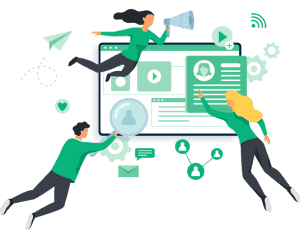AI system vs. AI agent vs. AI model – what to choose?
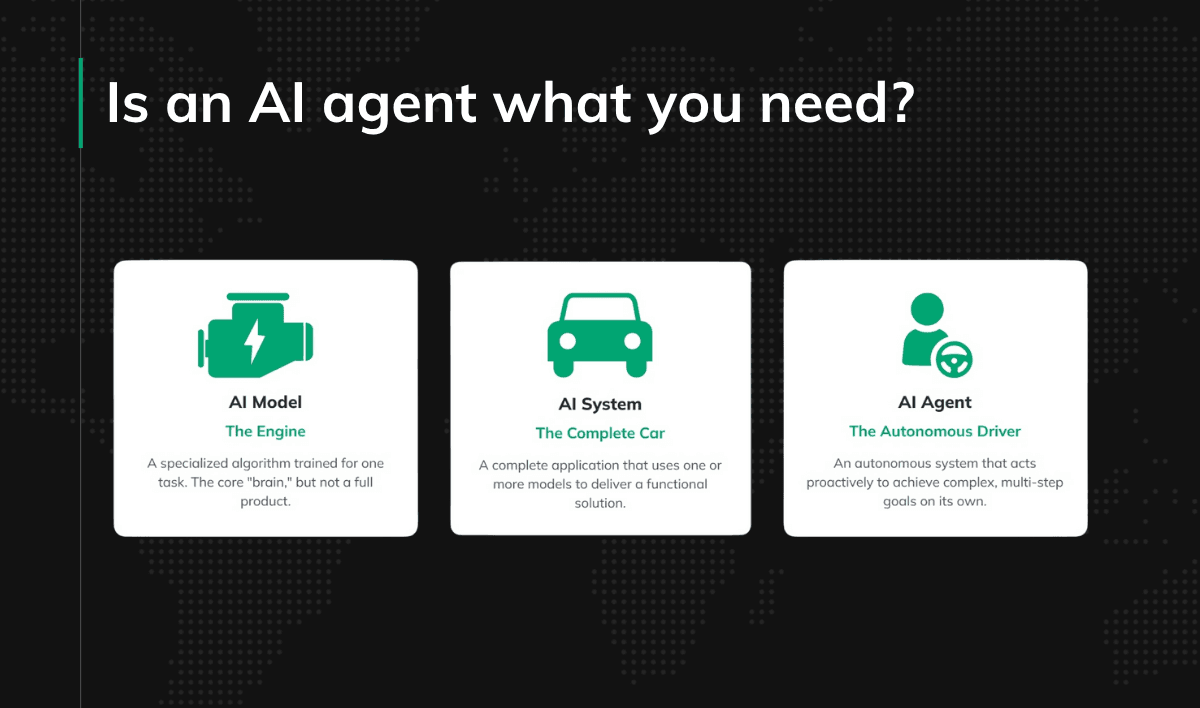
Let’s be frank: everyone’s talking about AI. But we’ve noticed that crucial terms like “models,” “agents,” and “systems” get thrown around interchangeably. Does it matter? From a pragmatic point of view, it absolutely does. Understanding these terms shows how AI can deliver real value.
So, what’s the difference between them, and do you actually need an AI agent?
Key Takeaways
- System vs. Model vs. Agent: An AI system is the complete, working car; the AI model is just the engine; and an AI agent is the autonomous driver that perceives the road and gets you to your destination on its own.
- Today, the vast majority of businesses are, and should be, focused on implementing AI systems rather than fully autonomous AI agents.
What exactly is an AI System?

So, what are we talking about when we say “AI system”?
An AI system is the whole machine: a working setup that runs on its own, at least to some extent. It uses one or more AI models to perform tasks, make decisions, or generate content that actually influences the world around it.
Legislation like the European Union’s AI Act gives a more formal definition:
“‘AI system’ means a machine-based system designed to operate with varying levels of autonomy, that may exhibit adaptiveness after deployment, and that, for explicit or implicit objectives, infers from the input it receives how to generate outputs such as predictions, content, recommendations, or decisions that can influence physical or virtual environments.” (EU Artificial Intelligence Act, Chapter I: General Provisions, Article 3: Definitions)
The European Commission actually created guidelines (Guidelines on the definition of an artificial intelligence system established by AI Act) that mention there are 7 key elements of AI systems:
| Element | Plain Explanation |
| Machine-based system | The system must run on a computer or digital hardware using software. That includes desktops, cloud servers, and even quantum computers. Both code and physical tech are included. If it doesn’t run on a machine, it’s not an AI system. |
| Designed to operate with varying levels of autonomy | The system must be designed to work at least somewhat on its own, even if a human gives it inputs. It doesn’t need to be fully independent, but it must do something without being told every step. |
| May exhibit adaptiveness after deployment | The system can be built to improve over time—for example, learning from new data. But this is optional: an AI system doesn’t have to adapt to be covered under the law. Static systems can still qualify. |
| Explicit or implicit objectives | The system must be built to achieve some kind of goal. This could be a clearly stated target (like “maximize accuracy” or “generate summaries”) or an inferred one (like goals emerging from data patterns). |
| Infers how to generate outputs | The AI system must be able to figure out, from inputs, how to produce an output (like a prediction or recommendation). This means it isn’t just following fixed rules written step-by-step by a human. |
| Produces outputs like predictions, content, recommendations, or decisions | The system must generate something useful—such as a guess about the future, a recommended action, a written article, or a direct decision. These are known as “outputs.” |
| Influences physical or virtual environments | The outputs the system creates must be able to affect the real world or digital space. For example, a navigation system steering a car, or a chatbot responding to users online. |
What’s the difference between AI system vs. AI model vs. AI agent?
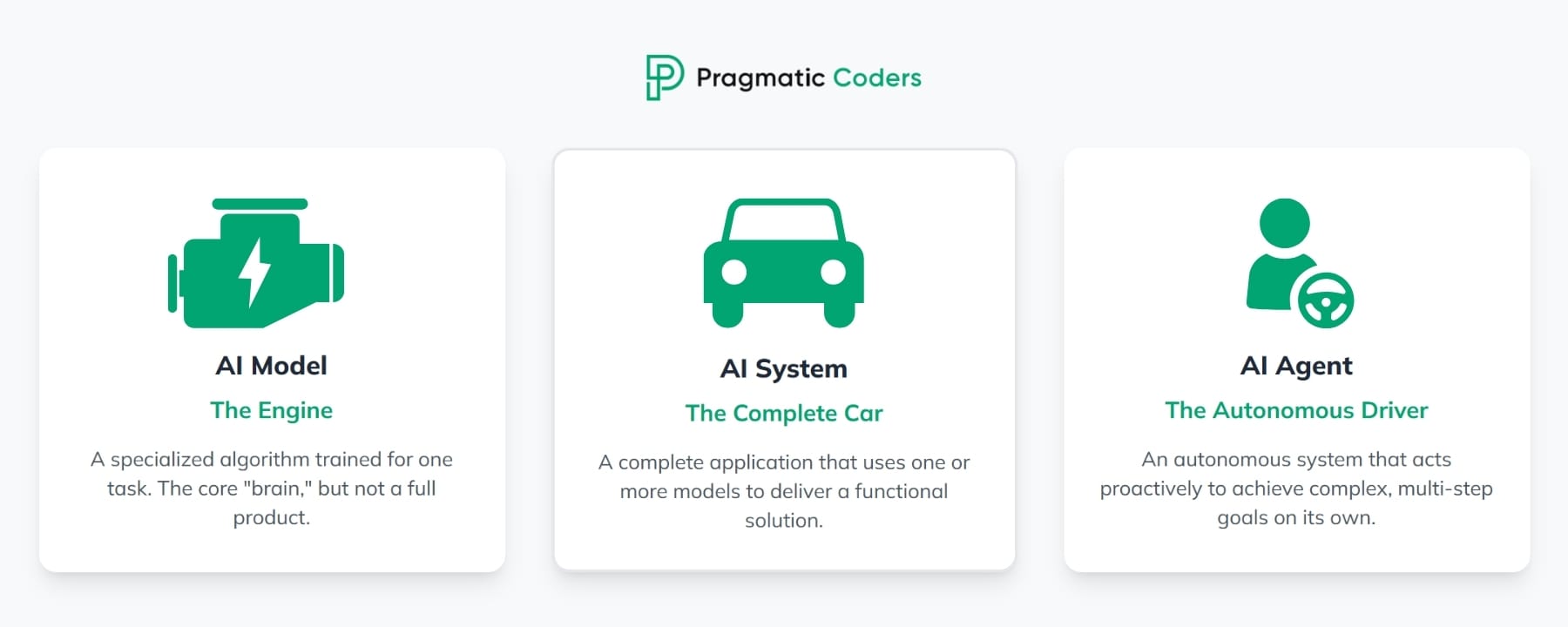
This is the single most important distinction to get right. An AI system is the entire application; the model is just one component inside it. The AI agent is like the next link in the chain of evolution. You can think of it as a system that’s been given a purpose and the freedom to act on it.
- AI system: Complete solution/app that integrates AI models.
- AI model: Engine/algo making predictions, but not a finished product.
- AI agent: Kind of an AI system that can act on their own, solve problems proactively, and carry out complex tasks without much human help. All agents are systems, but not all systems reach the autonomy and adaptiveness of agents.
| Characteristic | AI System | AI Agent (Advanced System) |
| Autonomy | May need regular human input | Highly autonomous, takes initiative |
| Proactivity | Usually reactive (waits for input) | Proactive (acts to fulfill a goal) |
| Task Execution | Provides info or recommendations | Plans/executes multi-step workflows |
| Use of Tools | Often limited, rules-driven | Can integrate with APIs, tools, memory |
| Example | Shows churn warning | Handles churn warning & customer action |
How do AI systems work and learn?
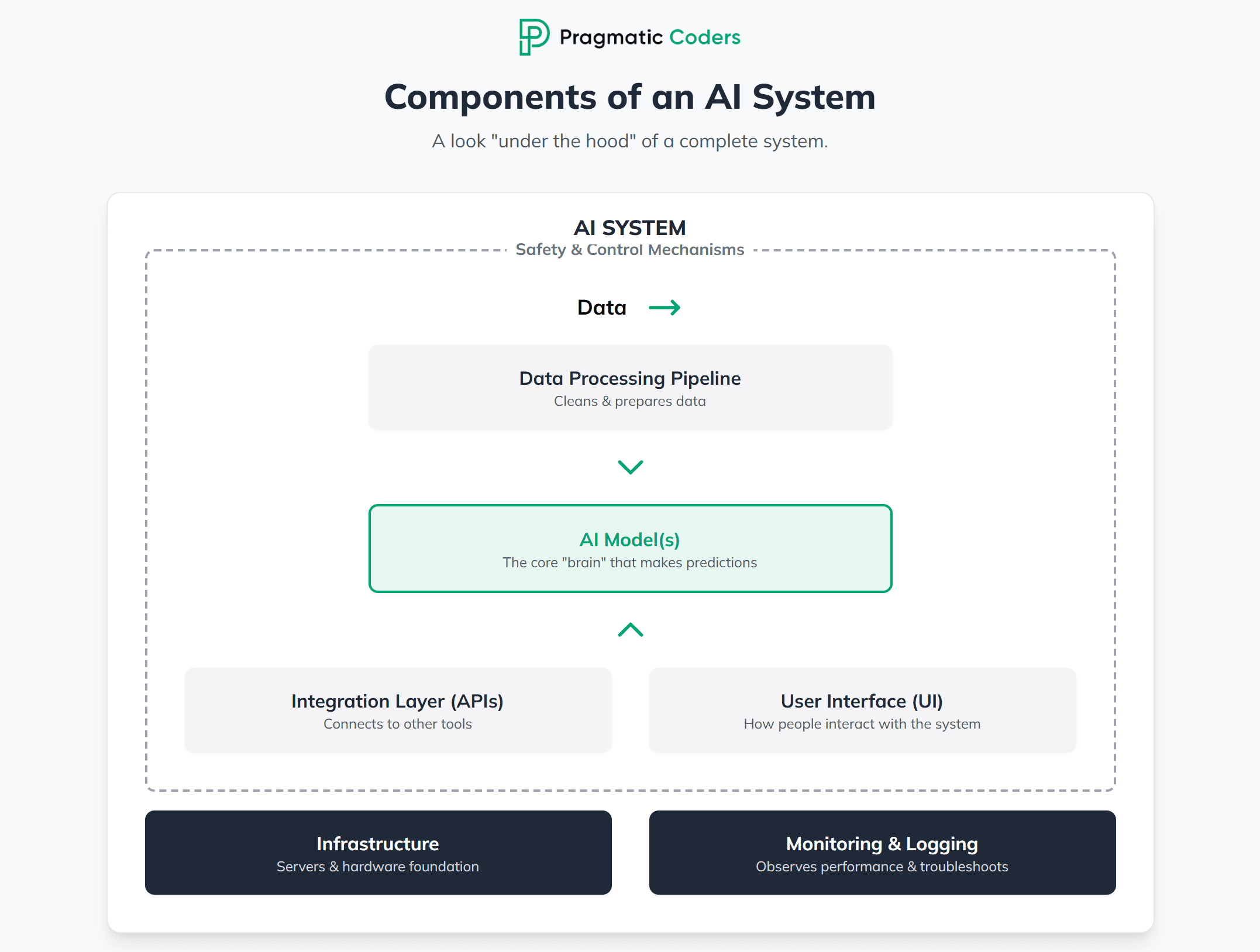
So, how does it all come together? Pragmatically speaking, a system takes in data, lets its core model “think,” and then produces an output or an action. But what’s really powerful is that many systems have a feedback loop so that they can learn from results and get smarter over time.
When we build these, we’re essentially assembling a team of specialized components:
- AI Model(s): The specialist “brain” of the operation.
- Data Processing Pipeline: The unsung hero that cleans and prepares data so the model can make sense of it.
- Integration Layer: The diplomat that allows the system to talk to other tools and APIs.
- User Interface (UI): The face of the system—how people actually interact with it.
- Infrastructure: The foundation of servers and hardware that keeps everything running smoothly.
- Safety and Control Mechanisms: The guardrails. Absolutely critical for making sure the system behaves reliably and ethically.
- Monitoring and Logging Systems: The system’s diary, which tells us what it’s doing and helps us troubleshoot when things go wrong.
How to decide if you need an AI model vs. AI system vs. AI system?
IN SHORT: Today, the vast majority of businesses are, and should be, focused on implementing AI systems rather than jumping straight to fully autonomous AI agents.
Let’s explain it in more detail.
From our perspective, it all comes down to a trade-off between efficiency and control, which is directly tied to trust.
AI systems often keep a human in the loop—they crunch data, suggest actions, or make predictions, but people make the final call. It’s a solid middle ground: you get the benefits of AI without giving up control. Plus, it helps tackle the “black box” issue by keeping things more transparent and trustworthy.
An AI agent, on the other hand, asks for a much higher level of trust because it is designed to act autonomously on your behalf. Because it works on its own, an AI agent raises bigger questions—like how we keep it safe, stay in control, and handle ethical risks, especially in sensitive areas.
- Also check: What AI automation service do I need?
Go from AI system → AI agent
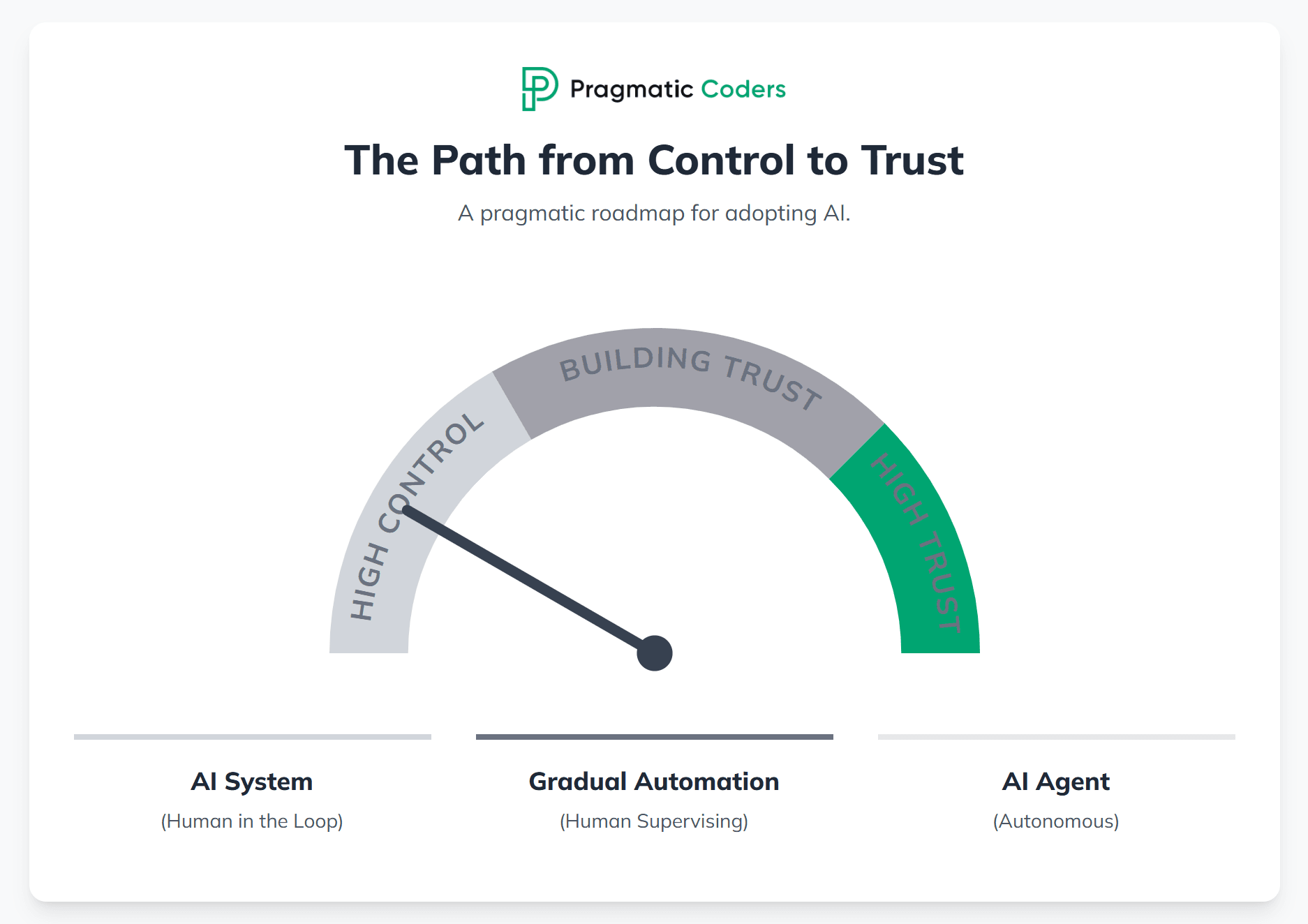
A pragmatic roadmap we often suggest is to start with an AI system to build that trust incrementally.
- Start by building a system that gives recommendations. As your team checks its output over time, you build up trust and confidence in what it delivers.
- Once trust and performance are clear, gradually increase the system’s autonomy until it can act as a true agent: independently on specific, well-defined tasks.
How do you build a practical AI System?
It takes more than good code to build an AI system that’s actually useful. Frankly, the technology is often the easier part. The hard part is making sure it tackles the right problem and fits into everyday operations.
This is where a pragmatic approach is non-negotiable: Does this feature really need AI, or is there a simpler way? Are we solving a core user need or just building cool tech?
To build a successful AI system, you need a partner who’s transparent and cares more about what works than just checking a box.
If that sounds like something for you, don’t hesitate – contact us.
An AI model is a single component—an algorithm trained to perform a specific task. An AI system is the complete, operational application that integrates one or more models with a user interface, data pipelines, infrastructure, and other necessary components to deliver a functional service. A typical AI system includes core AI models , a data processing pipeline , an integration layer for connecting to other services , a user interface , the underlying hardware and software infrastructure , safety and control mechanisms , and monitoring systems. AI systems are used across numerous industries. Key examples include healthcare (for diagnostics and drug discovery) , finance (for fraud detection and algorithmic trading) , and automotive (for autonomous vehicles and predictive maintenance).Q1: What is the difference between an AI model and an AI system?
Q2: What are the components of an AI system?
Q3: What industries use AI systems today?








